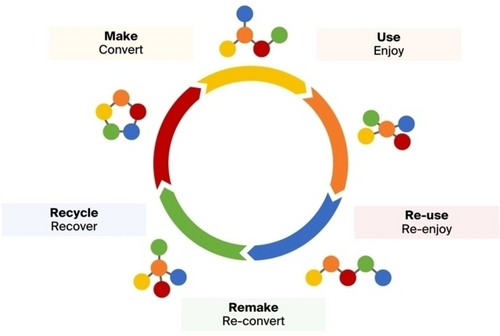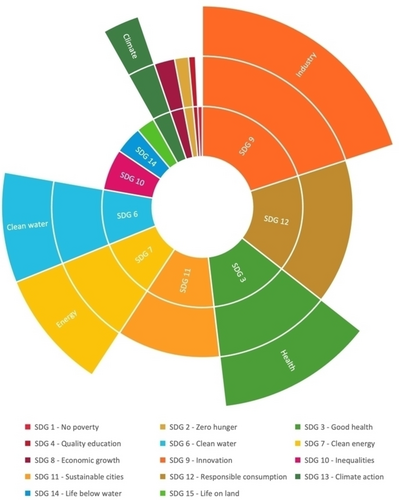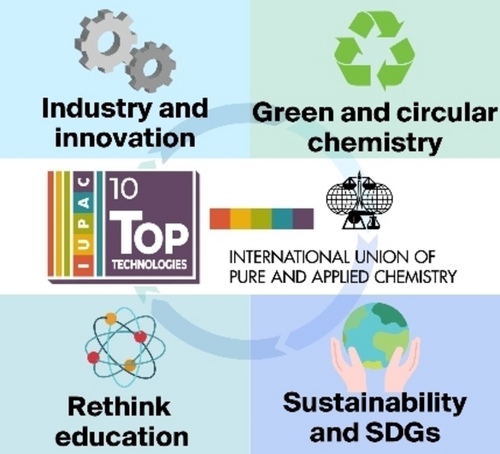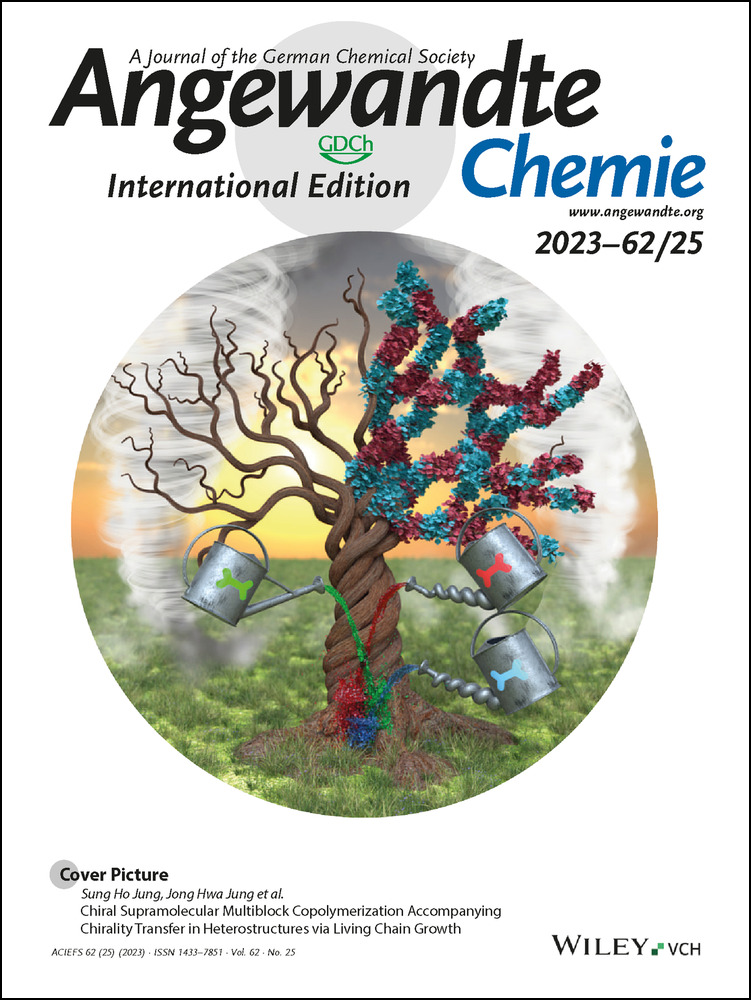Chemical Solutions to the Current Polycrisis
Graphical Abstract
Abstract
In the past 15 years, we've experienced an unprecedented series of crises, including financial (2008), health (2020), and most recently the supply chain disruptions and the energy emergency in Europe, caused by the war in Ukraine (2022). On top of that, climate change still poses a serious threat to our lives and our planet. These interconnected challenges create tremendous societal problems and compromise the viability of the chemical industry in an environment of price volatility and high inflation. Thus, the International Union of Pure and Applied Chemistry (IUPAC) has launched a series of actions to tackle this and raise awareness of the role of chemistry in solving our major threats. Since 2019, IUPAC has identified the “Top Ten Emerging Technologies in Chemistry” to connect chemical researchers with industry, bridging the gap between science and innovation, maintaining the current competitiveness of the chemical industry, as well as tackling our most pressing global challenges.
Lately, the climate crisis has become more evident than ever. Europe and Asia faced record-breaking temperatures during the first half of 2022, while other regions experienced wildfires, floods, and droughts of unprecedented severity. The poorest and most vulnerable members of society disproportionally suffer the consequences of these extreme events.1 To make things worse, the ongoing war in Ukraine has triggered an energy crisis, adding to the continuous disruptions in the worldwide supply chains, causing natural gas shortages and rising electricity bills. Overall, the World Economic Forum has dubbed this unprecedented situation as the “Polycrisis”, a term that summarises the simultaneous and overlapping crises of our day, including health, climate, war, inflation, and much more. Fortunately, chemistry could create and develop solutions for some of the problems we currently face, most caused by humans. To showcase some of these solutions and offer a roadmap for a more resilient and sustainable future, the International Union of Pure and Applied Chemistry (IUPAC) gathers experts from around the world every year, and together they review global nominations of emerging technologies that have the potential to reduce our dependence on fossil fuels, improve our quality of life, and fight illnesses. Ultimately, IUPAC selects the “Top Ten Emerging Technologies in Chemistry” every year. The initiative originated in 2019, alongside other IUPAC celebrations, including its centenary and the International Year of the Periodic Table. The goal of this annual activity is to identify and explain in simple terms different “emerging technologies” that are defined as advances that hover between early-stage laboratory discoveries and technologies with industrial applications—advances that have the potential to accelerate our transition towards a net-zero economy and a more sustainable future. Beyond celebrating its past and current contributions to the chemical community, the success of this initiative motivated IUPAC to venture into the future of chemistry.2 The “Top Ten” initiative has now become a consolidated and recognized selection of the most promising chemical technologies, which highlights the value of the chemical sciences in the transition to a green economy.3 Moreover, IUPAC supports many other initiatives to tackle the current crises, including the creation of a task force to pinpoint high technology readiness level (TRL) technologies to remediate problems such as plastic pollution and climate change, and the “Global Conversation on Sustainability,” co-organized with the International Young Chemists’ Network (IYCN), which provides a platform to catalyze conversations among local communities to find small-scale solutions for sustainability. Along these lines, IUPAC is also concerned about the future of raw materials, and studies solutions to problems such as the excessive accumulation of electronic waste (e-waste).4 Chemistry, as well as a better understanding of supply chains and the dynamics of global markets, will provide comprehensive solutions to problems in the most affected areas. In fact, IUPAC very recently organized a conference on the topic of e-waste in Nigeria. Overall, IUPAC's goal is to stop talking and start taking real action.
Luckily, IUPAC isn't alone in this endeavor. In 2022, we began the celebration of the International Year of Basic Sciences for Sustainable Development (IYBSSD), an ambitious program to highlight the value of basic, curiosity-based sciences to stimulate innovation, as well as their huge potential as a powerful educational and training tool. All these points are also recognized in the Royal Society of Chemistry's report on the future of chemical sciences.5 Similarly, the United Nations (UN) have created an International Panel on Chemical Pollution (IPCP), following the steps and learnings of the International Panel on Climate Change (IPCC), to elaborate and provide reports and evidence-based information for policymakers and the wider public. All these initiatives aim at bridging the gap between scientific research and innovation, assisting scale-ups, technology transfers, connections, and development. This is instrumental to overcoming the societal challenges we currently confront.
The good news is that the solutions already exist. And the goal of IUPAC's “Top Ten” initiative is to catalyze innovation by raising awareness around promising emerging technologies among policymakers and industry leaders (Table 1 and Table 2 list all the technologies selected by IUPAC experts since 2019, as well as the contribution of each of them to the UN's Sustainable Development Goals (SDGs)). The industrial importance of this initiative is showcased by the support of the Spanish Federation of Chemical Industries (FEIQUE), which sponsored the program in 2022, and the increased number of submitted nominations to the pool of suggested technologies from start-ups and chemical companies. For example, the “Top Ten” lists have continuously highlighted up-and-coming innovations in the field of batteries, given that storing energy is one of the most pressing problems today. First, because Nobel-award winning lithium-ion batteries have issues in terms of long-term stability and safety; second, batteries heavily rely on critical raw materials such as cobalt and have created strategic supply squeezes in South America; last, but not least, bulky batteries cannot meet the demands of clean energy sources, such as intermittency. Since the initiative started in 2019, batteries have been included on several of the “Top Ten” lists, including solid-state batteries, dual-ion batteries, fiber batteries and, finally, sodium-ion batteries. The latter reflects the spirit of sustainability and supports the UN's SDGs. Not only is sodium more abundant than lithium, but also aluminum—which replaces copper in the anode—is more abundant than copper and offers a cheaper, lighter, and more resilient alternative. This combination of abundant elements makes batteries greener, while avoiding the problems associated with excessive discharge such as the thermal runaway and flammability of lithium-ion-based devices.6 Another technology highlighted in the 2022 IUPAC “Top Ten” list that reflects this trend towards greener and more efficient energy solutions is the development of solar fuels and artificial photosynthesis. Inspired by nature, chemists have developed catalytic processes, including photo- and electrocatalytic methods, that transform carbon dioxide, water, and sunlight (or other sources of clean electricity) into energy-rich substances, such as alcohols, small hydrocarbons, hydrogen, and ammonia, all of which have diverse applications as fuels and raw materials in the chemical industry. Chemical and solar fuels could also solve the intermittency issues of fluctuating power sources, and have been described as a solution to “bottle renewables” and store, transport and distribute energy more efficiently.7 Since the start of the project, the “Top Ten” lists also delve into modern methods beyond the bench, such as artificial intelligence (AI), blockchain and other encrypted technologies, and virtual-reality-enabled interactive modelling. Chemistry is constantly changing, and while AI and robotics are rarely taught in chemistry curricula, the digitalization of chemistry will soon create rewarding revenues, as well as contribute to the decarbonization of our industry.8
Technology[a] |
SDGs[b] |
Technology |
SDGs |
|---|---|---|---|
Nanopesticides |
2, 3, 6, 15 |
Aggregation emission |
7, 9 |
Enantioselective organocatalysis |
3, 9, 12 |
Dual-ion batteries |
7, 9, 11, 12, 15 |
Solid-state batteries |
7, 9, 11, 12 |
AI applied to chemistry |
3, 9, 10 |
Flow chemistry |
6, 9, 12 |
High-pressure chemistry |
9, 12 |
Reactive extrusion |
6, 9, 12, 13 |
Liquid gating technology |
6, 7, 14 |
Metal-organic frameworks |
3, 6, 7, 13 |
Macromonomers |
11, 12, 14 |
Directed evolution |
3, 9 |
Microbiome compounds |
3, 6, 10 |
Plastics to monomers |
11, 12, 14 |
Nanosensors |
3, 12, 14 |
RDRP[c] |
11, 12, 14 |
Rapid diagnostics |
3, 9, 10 |
3D bioprinting |
3, 9 |
RNA vaccines |
3, 9, 10 |
- [a] IUPAC Top Ten Emerging Technology. [b] UN Sustainable Development Goals associated with each technology. [c] Reversible deactivation of radical polymerization.
Technology[a] |
SDGs[b] |
Technology |
SDGs |
|---|---|---|---|
Artificial humic matter |
2, 6, 8, 12, 15 |
Aerogels |
7, 9, 11 |
Blockchain technology |
9, 11, 12 |
Fibre batteries |
7, 9, 12 |
Chemi-luminescence |
9, 11 |
Fluorescent film sensors |
3, 6, 11, 14 |
RNA and DNA synthesis |
3, 10, 12 |
Liquid solar fuels |
7, 8, 9, 10, 11, 12, 13 |
Semi-synthetic life |
3, 6, 9, 11, 12 |
Nanoparticle megalibraries |
7, 9, 11, 12 |
Single-cell metabolomics |
3, 9 |
Nanozymes |
3, 6, 9, 10 |
Sonochemical coatings |
6, 7, 12 |
Rational SNA vaccines |
3, 9, 10 |
Superwettability |
6, 7, 9 |
Sodium-ion batteries |
7, 9, 11, 12, 15 |
Sustainable ammonia |
1, 7, 11, 12, 13 |
Textile displays |
9, 11, 12 |
Target protein degradation |
3, 9 |
VR-enabled modelling |
4, 8, 9, 10 |
- [a] IUPAC Top Ten Emerging Technology. [b] UN Sustainable Development Goals associated with each technology.
The “Top Ten” also provides a unique and clear roadmap to rethink chemistry altogether. Following the basic principles of green chemistry, laid out by Paul Anastas and John Warner almost 25 years ago,9 IUPAC wants to provide a roadmap towards more sustainable chemistry. Incremental improvements won't change the paradigm—it's now time to re-imagine chemistry, as well as the way we teach and implement these ideas. For example, we must make molecules more efficiently, maximizing atom economy and generating less waste. As it stands, over 99 % of the major industrial chemical processes involve the transgression of at least one planetary boundary—which makes them environmentally unsustainable.10 Thus, we must rethink these strategies and, at fundamental levels, build molecules that by design are easily recycled or repurposed (see Figure 1). This is even more necessary in times of crises and supply chain challenges, when chemistry can provide the tools to turn waste into raw materials. If processes guarantee traceability, recyclability, and reuse, we could consolidate chemistry as at the center of circular economy, and provide solutions to tackle the climate crisis and guarantee our wellbeing.11

Beyond green chemistry, we need to rethink chemistry from conception to applications, towards a circular approach that relies on recycled and reused raw materials instead of depleting the limited resources we have. Adapted from Ref. [11a].
As exemplified by some of the “Top Ten” technologies, we need novel strategies to reduce the ravaging of raw materials, including processes and policies to protect critical chemical elements, as well as the decentralization of extractive processes to ensure fair and equitable access to resources for all.12 Finally, as mentioned earlier, chemists could conceive solutions for better energy harvesting and storage, from solar cells and photocatalysts to batteries and supercapacitors. Although now deeply rooted in our everyday lives, the oil-based economy is relatively recent, and cleaner alternatives must become mainstream as soon as possible in order to guarantee that we meet the urgent demands of the UN SDGs and potential global climate impacts. To that end, Figure 2 explores the relationships between the different “Top Ten” technologies (2019–2022) and the SDGs, according to the authors of this paper. The Figure reflects how these key chemical technologies relate to fundamental societal challenges, correlated to the current crises, i.e. responsible consumption, innovative industry, health, and energy.

Contribution of the IUPAC “Top Ten Emerging Technologies” to the United Nations’ Sustainable Development Goals (SDGs). Bigger sectors represent an SDG that appears more often in the classification of the “Top Ten” technologies, and smaller sectors refer to minority SDG, which leave room for future improvement, i.e. Quality Education (SDG 4). For further details on the contributions of each technology refer to Tables 1 and 2 in this paper.
With that in hand, it's time to tackle technology transfer and bridge the gap between academia and industry. Luckily, the barriers between the two sectors are breaking. Several systems put in place by universities and companies guarantee collaboration and cross-pollination of ideas. Similarly, funding bodies around the world have started new strategies to accelerate the development and scale-up of breakthrough technologies, like the European Innovation Council (EIC), an initiative recently launched by the European Commission with a €10 billion budget to support technology transfer, including start-ups and SMEs, and the National Science Foundation Seed Fund program.13 In fact, scientific entrepreneurship is an often-overlooked aspect that plays a fundamental role in technology transfer. Start-ups and spin-offs create value, jobs, and opportunities, as well as pilot demonstrations that catalyze the transformation of chemical concepts into commercial realities. In deep tech and computing, start-ups often get absorbed by bigger companies in efforts to diversify portfolios and acquire know-how on innovative methods. Similarly, big chemical firms could make the most of exciting new discoveries if some scientists decide to transfer their technologies to the market or even launch their own companies.14 Moreover, the “Top Ten” list provides a strong statement from IUPAC, as an authority and established opinion leader in chemistry, which highlights the trends and promising projections of uttermost interest to the chemical enterprise. Some of the nominated and ultimately selected “Top Ten” technologies have been recognized worldwide with awards and strong industry investments. Examples include enantioselective organocatalysis (2019), a technology that was recognized with the Nobel Prize in Chemistry in 2021; AI applied to chemistry (2020), which found successful applications such as Deepmind's Alphafold and, more recently, Meta's protein prediction tool;15 and the sustainable production of ammonia (2021), a solution at the core of three green hydrogen megaprojects in South America, Australia, and the Middle East.16 Hovering between discrete discoveries and enterprise endeavors, the “Top Ten” have the potential to reshape full fields in the chemical industry, showcasing the considerable capability of chemistry to interconnect the sciences and provide problem-solving alternatives.
Beyond research and industry, the “Top Ten” also explores innovation in areas such as chemistry education. For example, the 2022 list includes virtual reality- and augmented reality- enabled modelling, recognizing the huge potential of mixed realities to enhance comprehension among chemistry students and catalyze quicker discoveries in computational chemistry. Education is at the very heart of IUPAC's mission, and rethinking chemistry education is key to making circular chemistry possible.17 We must think of sustainability at the beginning of any chemical process, and throughout its whole life, from its initial conception to its implementation in the plant and beyond, taking into account ecological impacts and lifecycle analyses. For this reason, years ago IUPAC embarked on a major project to rethink chemistry education from the perspective of system thinking—a new way of embracing complexity. With system thinking, we analyze problems looking at relationships instead of isolated concepts, providing the basis for a new approach of teaching chemistry. This strategy would go beyond structures and reactivity, connecting molecules with the problems and opportunities of the world around us. Since 2018, a group of experts in chemical education and sustainable chemistry has been working to design educational materials and raise awareness about the importance of explaining chemistry from a global perspective. The result of this IUPAC project is an online education resource created by the King's Centre for Visualization in Science, in Canada, a free interactive tool for global dissemination based on the Planetary Boundaries framework to help chemists and educators better understand Earth system sustainability challenges and to connect chemistry to sustainability using systems thinking.
Now, the IUPAC “Top Ten” initiative is widely recognized within the chemistry community as a catalyst for a better, more sustainable world.18 The most recent list (published in 2022) focused on fostering solutions to real-world problems and the current crises, including the scarcity of resources and raw materials, the ever-pressing energy emergency and climate change without ignoring other challenges, such as the increased risk of new diseases and health threats. If you want to engage and interact with this initiative, whether you work in academia, industry, or any other chemistry-related field, please visit the IUPAC website (https://www.iupac.org). We look for sponsors, collaborators, and suggestions for new emerging technologies. Every chemist is encouraged to submit nominations and ensure that IUPAC experts have a large pool of technologies to select from, further contributing to the expansion and establishment of this initiative. Join us, and IUPAC, in this exciting journey.
Disclaimer
The opinions expressed in this publication are the views of the authors and do not necessarily reflect the opinions or views of Angewandte Chemie International Edition/Angewandte Chemie, the Publisher, the GDCh, or the affiliated editors.
Acknowledgments
We want to acknowledge the efforts of the experts appointed by IUPAC who reviewed the many global nominations of emerging technologies from 2019 to the present, ultimately selecting the “Top Ten” each year, including Michael Dröscher, Sophie Carenco, Jorge Alegre Cebollada, Javier Garcia-Martínez, Ehud Keinan, Rai Kookana, Christine Luscombe, Carolyn Ribes, Greg Russell, Ken Sakai, Zhigang Shuai, Natalia P. Tarasova and Bernard West. Additionally, we want to especially thank Bonnie Lawlor for revising this paper and improving its quality tremendously, as well as Fabienne Meyers and Lynn Soby for their continuous support of the IUPAC “Top Ten” initiative and the fruitful comments and edits that made every single edition outstanding.
Conflict of interest
F.G.-B. is paid by IUPAC to write the feature articles on the Top Ten Emerging Technologies in Chemistry and promote this initiative on social media. J.G.-M. is currently, and will be until the end of 2023, the President of IUPAC.
Open Research
Data Availability Statement
The data that support the findings of this study are available from the corresponding author upon reasonable request.
Biographical Information
Javier García-Martínez is the president of IUPAC, Professor of Inorganic Chemistry at the University of Alicante (Spain). He has published extensively in the areas of nanomaterials, catalysis, and energy. He founded the start-up Rive Technology, which was later acquired by Grace. He has published books on chemical education (2015) and chemical entrepreneurship (2021), both with Wiley-VCH.
Biographical Information
Fernando Gomollón-Bel studied chemistry, then specialized in science writing and science communication. After working for institutions like the Institute of Chemical Research of Catalonia (ICIQ; Spain) and the University of Cambridge (UK) he has co-founded Agata Communications, a small start-up dedicated to making complicated things easy. He also writes for publications such as Chemistry World and Chemical & Engineering News.







